A new study explores whether and how mom cats might recognize their offspring.
You’ve probably seen dozens of “mom cat foster” stories on the internet – where mom cats are given a baby animal (sometimes of another species) to care for. It’s not uncommon for rescue groups, upon receipt of an orphaned kitten, just latch them on to a cat who is already nursing a littler. Much like Paul McCartney, these mom cats often just say “Let ‘em in.”
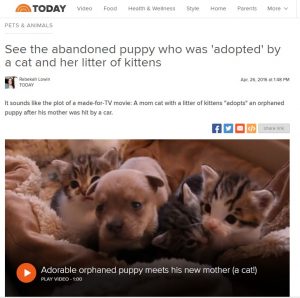
Cat nurses a baby skunk:
A cat nurses ducklings?????
From an evolutionary perspective, it doesn’t make a lot of sense for animals to invest time and energy care for unrelated young – it could increase risk of predation when moms have to spend more time searching for food for that new mouth to feed. It could even mean less success for an animal’s own babies. Adoption (and its dangers) sometimes unintentionally happens in nature – most commonly via what is called “brood parasitism” where a bird lays an egg in another bird’s nest. In the case of the Cuckoo, they lay eggs in Reed Warblers’ nests, and once they hatch, the young cuckoos wiggle around so much that they push their adoptive mom’s eggs out of the nest.
So why would cats be so willing to take on extra, unrelated babies? A new study looked at whether mom cats were discriminating in their care of kittens, depending on if they were her own or from another litter (referred to as “aliens”). The recent publication, “Can but don’t: olfactory discrimination between own and alien offspring in the domestic cat,” published in the journal Animal Cognition, also looked at whether or not mom cats could tell the difference between her own and alien offspring by just using their sense of smell.
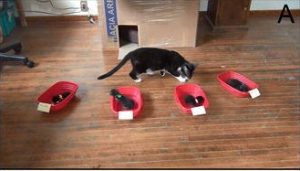
In Experiment 1, twelve recent mothers were presented with an array of kittens in little dishes (to prevent them from rolling around). The kittens were <7 days old. Two of the kittens were the mother’s offspring, and two were alien. The experimenters recorded how long it took for the mom to investigate each kitten, and if she retrieved them and carried them back to the nest. Moms showed no differences in behavior toward their own and alien kittens, aside from spending more time sniffing alien kittens. Seven of the mom cats retrieved all 4 kittens, two brought back two kittens (one of their own and one alien kitten in both cases) and the other three mom cats did not return any kittens to her nest.
So now we have a new question – did moms bring back alien kittens because they could not discriminate between which kittens were theirs and which were alien, or did they just not care?
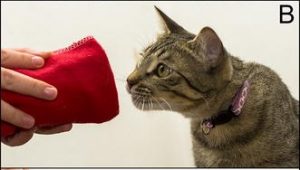
To test this, Experiment 2 involved presenting the mom cat with a kitten wrapped in a small towel, with only the anogenital region (hereafter referred to as “kitten booty”) available for sniffing. The mom was presented with three of her own kitten’s booties, then the booty of an alien kitten. Sniffing time was noted for each presentation. Mom cats habituated to the smell of their own kittens, sniffing each booty a decreasing amount of time. But the presentation of the alien kitten booty led to a significant increase in sniffing time, suggesting that the mom cat could detect that something was different about this fourth booty.
To be sure that this discrimination wasn’t due to some other factors, such as visual recognition of the kitten booty or the possibility that the kittens were emitting ultrasonic vocalizations, a third experiment was conducted where the moms were presented with four Q-tips instead of four booties.
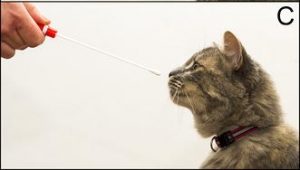
The first three Q-tips had each been rubbed on three of the mom’s own kittens, and the fourth Q-tip was rubbed on an alien kitten. The swabs were rubbed all over the kitten, including their faces, stomach, and anogenital region. Shortly afterward, the Q-tips were presented to the mom cat in a similar manner as the booties had been. Again, the mom showed habituation to the smell of her own babies, and spent more time sniffing the alien kitten Q-tip.
Combined, these studies demonstrate that mom cats can distinguish differences between kittens who are their biological offspring, and kittens who aren’t. Moms seem less discriminating when it comes to rescuing kittens who are separated from their nest. So why would that be?
Although I really enjoyed this paper, the one thing that bothered me was the continual reference to cats as “solitary.” A more modern understand of cat sociality clearly demonstrates that group living, and matrilineal societies are not unusual in environments where resources are adequate.
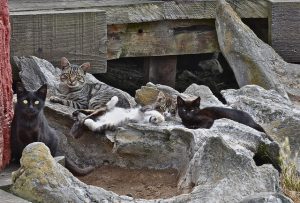
In these cases, if mom cats are highly likely to be near closely related female cats, then the costs of co-mothering (from an evolutionary/fitness perspective, where the goal is to ensure your genes are passed on) are small. In fact, if this behavior is reciprocal, then your own offspring would have a greater chance of surviving if another mom cat (probably one of your relatives) was willing to care for YOUR kittens.
Moms have litters that on average have 3-5 kittens. But they can have eight (or apparently, sometimes even more) nipples. Although each nursing baby would come with additional nutritional costs for mom, she can accommodate more kittens than she usually gives birth to.
Thus, it should not be surprising that mom cats would be willing to nurse other animals – they have nipples to spare, and under many conditions, even if they did pick up some nearby kittens, there would be a good chance that those kittens would be related, thus taking care of those kittens may not present a lot of costs for your average mom cat.

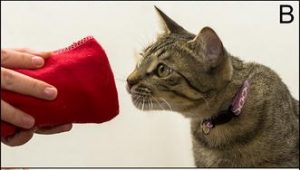
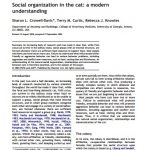
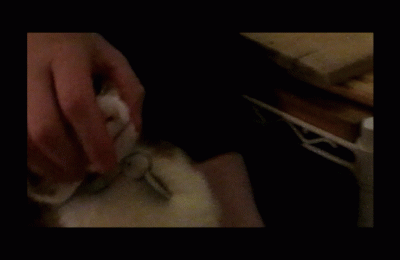
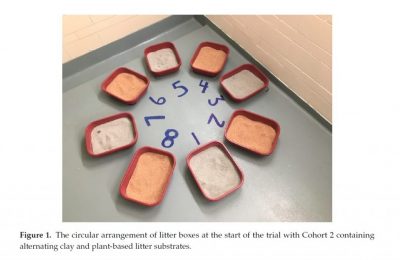
2 thoughts on “Sniffing kitten butts for science?”
Comments are closed.